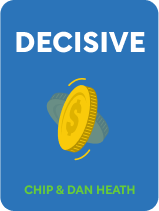

This article is an excerpt from the Shortform book guide to "Decisive" by Chip and Dan Heath. Shortform has the world's best summaries and analyses of books you should be reading.
Like this article? Sign up for a free trial here.
How does overconfidence affect decision-making? What are some ways to mitigate hubris in your decision-making?
Our hubris—or overconfidence in decision-making—makes us feel certain in our predictions about a decision’s outcome. If the outcome is different than we predicted, we’re left surprised and unprepared to deal with it. We can overcome our hubris by: 1) accepting that we can’t predict the future, and 2) preparing for a range of possible outcomes.
Here are some strategies for overcoming decision-making hubris.
Strategy 1: Make Contingency Plans
The authors share that one way to prevent overconfidence in decision-making is to prepare for both best-case and worst-case scenarios. By planning for both types of scenarios, we ensure that the worst-case scenario won’t be devastating and that we’ll be more prepared for the success of the best-case scenario.
For example, consider a woman who decides to quit her job and open a food truck. First, she imagines a worst-case scenario and makes a plan for it.
- Worst-case scenario: An accident totals her food truck.
- Plan: She guards against this outcome by purchasing insurance.
Next, she imagines a best-case scenario and makes a plan to be ready for it.
- Best-case scenario: A food critic’s rave review doubles her number of customers.
- Plan: She contacts several friends who work in food service. She tells them that if her demand starts to double, she’ll offer them a job to join her in the kitchen.
Strategy 2: Prepare for the Unexpected
When it’s challenging to accurately predict a decision’s worst-case outcomes, we can still prepare for the unforeseeable. The authors argue that even though our hubris will cause us to underestimate the worst-case scenario, we can negate that hubris by working “safety factors” into our predictive calculations. A safety factor is a cushion we can add to our prediction of the worst-case scenario. If it turns out that the worst-case scenario was too optimistic, then the safety factor helps us avoid disaster.
For instance, imagine that the food truck owner estimates her business expenses. She multiplies those estimated expenses by a safety factor of 1.5. That way, if it turns out her estimate fails to account for unexpected costs, she avoids draining her bank account.
Strategy 3: Create an Alert
A final step we can take to prepare for future outcomes is to ensure that we act early if we notice any signs that our decision is headed towards a negative outcome. Our hubris may tempt us to ignore these signs, so the authors recommend that we humbly assume our decision will have negative outcomes. They advise us to proactively create an alert: a reminder for us to act that fires in response to early signs of a negative outcome. Alerts ensure that we recognize when it’s time to follow up our decision with another decision that steers us off the path toward a negative outcome.
One type of alert that the authors offer is a deadline. After you make a decision, choose a date in the near future. When that date arrives, evaluate the success of your decision so far and determine whether you need to change course.
Another type of alert that the authors offer is a pattern. After you make a decision, list several possible warning signs that the decision is headed towards a negative outcome. If you notice a pattern of more than one warning sign, it’s a signal that you need to either re-evaluate your decision or follow it up with another one.
For example, imagine a teacher in a classroom that has several students who are new to the school. He wants to ensure that they’re integrating well with their peers, and he determines that sitting alone at lunch would be a sign of poor integration. Each day, he observes the students eating. If he ever notices that a student sits alone more than two times, this pattern alerts him to decide how to better support them.
Alerts Help to Counter Passive Living
As well as helping you to counteract hubris, alerts help you overcome another issue that the Heath brothers highlight: passive living. This is when you proceed through life without actively reflecting on your daily behavior. The authors argue that when we live passively, we often fail to recognize opportunities to follow up on our decisions. An alert helps us recognize these opportunities.
For example, consider someone who decides to buy a car. Not long after this decision, they slip into passive living and fail to notice the car’s gradual deterioration. It may not occur to them that they should decide to get a tune-up or purchase a new one in better condition.
| The Popularity of Books on Choice and Decision-Making Decisive is one of many books on the topic of decision-making that’s been published in the past several decades. Why is decision-making such a popular topic, especially in the United States? It’s possible that this popularity reflects the value that American culture places on choice. One psychologist argues that the US value of choice dates back to the United States’ founding. During this time, several prominent thinkers influenced American values around choice: For example, economist Adam Smith proposed the idea that individual self-interest drives economic growth, and Ralph Waldo Emerson’s ideas about self-reliance encouraged people to value individual choice over conformity. Choice and independence continue to be cornerstones of American culture that the U.S. government articulates in official documents today. |

———End of Preview———
Like what you just read? Read the rest of the world's best book summary and analysis of Chip and Dan Heath's "Decisive" at Shortform.
Here's what you'll find in our full Decisive summary:
- Why our minds are wired to make bad decisions
- How biases and cognitive flaws distort your thinking
- A four-step process to improve your decision-making






